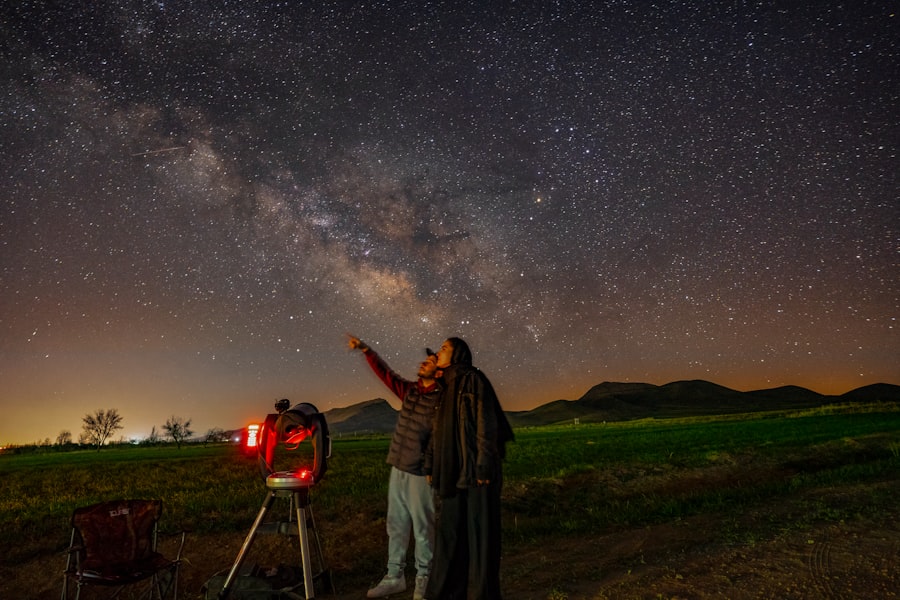The history of telescope technology is a fascinating journey that spans several centuries, beginning in the early 17th century. The invention of the telescope is often attributed to Hans Lippershey, a Dutch spectacle maker, who in 1608 applied for a patent for a device that could magnify distant objects. Shortly thereafter, Galileo Galilei improved upon this design, creating his own telescope in 1609.
Galileo’s version was capable of magnifying objects up to 20 times, allowing him to make groundbreaking astronomical observations. He famously documented the moons of Jupiter, the phases of Venus, and the rugged surface of the Moon, fundamentally altering humanity’s understanding of the cosmos. As the 17th century progressed, telescopes evolved significantly.
The introduction of the refracting telescope by astronomers such as Johannes Kepler further enhanced observational capabilities. Kepler’s design utilized a convex lens to produce a wider field of view and greater clarity. This period also saw the emergence of larger telescopes, with notable figures like Isaac Newton contributing to advancements in telescope technology.
Newton’s invention of the reflecting telescope in 1668 utilized mirrors instead of lenses, which helped eliminate chromatic aberration—a common issue with refracting telescopes. This innovation paved the way for more powerful telescopes that could observe fainter celestial objects.
Key Takeaways
- Telescopes have a long history dating back to the 17th century, with advancements in technology leading to improved capabilities over time.
- Telescopes have played a crucial role in space exploration, allowing scientists to observe distant celestial bodies and gather valuable data.
- Advancements in space telescope technology, such as the Hubble Space Telescope, have revolutionized our understanding of the universe and provided stunning images of distant galaxies and nebulae.
- Telescopes have greatly impacted our understanding of the universe by allowing us to study celestial objects, phenomena, and the evolution of the cosmos.
- The future of space telescopes holds great promise for further discoveries, with upcoming missions aiming to explore exoplanets and search for signs of extraterrestrial life.
The Role of Telescopes in Space Exploration
Telescopes have played an indispensable role in space exploration, serving as our eyes into the vastness of the universe. Ground-based telescopes have long been used to study celestial phenomena, but their capabilities are limited by Earth’s atmosphere, which distorts light and restricts observations. The advent of space telescopes marked a significant turning point in astronomical research.
By placing telescopes beyond the atmosphere, scientists can capture clearer images and gather data across a broader spectrum of wavelengths, including ultraviolet and infrared light. One of the most notable examples of a space telescope is the Hubble Space Telescope, launched in 1990. Hubble has provided stunning images and invaluable data that have transformed our understanding of the universe.
It has contributed to discoveries such as the acceleration of the universe’s expansion and the existence of exoplanets. Hubble’s ability to observe distant galaxies and nebulae has allowed astronomers to study the formation and evolution of cosmic structures over billions of years. The insights gained from Hubble have not only advanced scientific knowledge but have also inspired public interest in space exploration.
Advancements in Space Telescope Technology

The field of space telescope technology has seen remarkable advancements since the launch of Hubble. New telescopes are being designed with cutting-edge technology that enhances their observational capabilities and expands our understanding of the universe. One such advancement is the development of larger mirrors, which allow for greater light-gathering power and improved resolution.
The James Webb Space Telescope (JWST), launched in December 2021, exemplifies this trend with its primary mirror measuring 6.5 meters in diameter—more than two and a half times larger than Hubble’s mirror. In addition to larger mirrors, modern space telescopes are equipped with sophisticated instruments that enable them to observe a wide range of wavelengths. JWST, for instance, is designed to observe infrared light, which is crucial for studying cooler objects in space, such as distant galaxies, star-forming regions, and even exoplanets’ atmospheres.
The ability to capture infrared data allows astronomers to peer through cosmic dust clouds that often obscure visible light, revealing hidden structures and phenomena that were previously inaccessible.
The Impact of Telescopes on our Understanding of the Universe
| Telescope | Impact |
|---|---|
| Hubble Space Telescope | Provided high-resolution images of distant galaxies and helped to determine the age of the universe |
| Kepler Space Telescope | Discovered thousands of exoplanets, revolutionizing our understanding of planetary systems |
| Chandra X-ray Observatory | Revealed the presence of black holes and provided insights into the behavior of high-energy phenomena in the universe |
| James Webb Space Telescope | Expected to provide unprecedented views of the early universe and the formation of galaxies |
Telescopes have profoundly impacted our understanding of the universe by enabling astronomers to explore celestial phenomena that were once beyond reach. The ability to observe distant galaxies has provided insights into the universe’s structure and evolution. For example, Hubble’s deep field images revealed thousands of galaxies in a tiny patch of sky, demonstrating that the universe is far more vast and populated than previously thought.
These observations have led to the realization that galaxies are not static but are constantly evolving through processes such as mergers and interactions. Moreover, telescopes have played a crucial role in advancing our knowledge of cosmic events such as supernovae and gamma-ray bursts. By studying these explosive phenomena, astronomers have gained insights into stellar life cycles and the mechanisms driving these cataclysmic events.
Telescopes have also contributed to our understanding of dark matter and dark energy—two mysterious components that make up a significant portion of the universe’s mass-energy content. Observations of galaxy clusters and their gravitational effects have provided evidence for dark matter’s existence, while studies of distant supernovae have revealed the accelerating expansion of the universe attributed to dark energy.
The Future of Space Telescopes
The future of space telescopes promises even more exciting discoveries as technology continues to advance. Upcoming missions aim to address some of the most pressing questions in astrophysics and cosmology. For instance, the European Space Agency’s Euclid mission, set to launch in 2023, will focus on mapping dark energy and dark matter across the universe.
By surveying billions of galaxies, Euclid aims to shed light on how these enigmatic components influence cosmic structure formation. Another ambitious project is the Wide Field Infrared Survey Telescope (WFIRST), which will explore exoplanets and investigate the nature of dark energy through large-scale surveys. WFIRST’s capabilities will allow astronomers to conduct detailed studies of exoplanet atmospheres and search for signs of habitability.
As technology progresses, we can expect even more sophisticated instruments capable of probing deeper into space and time, potentially uncovering new phenomena that challenge our current understanding.
How Telescopes Help Scientists Discover New Planets

Telescopes have been instrumental in the discovery of new planets beyond our solar system—exoplanets—transforming our understanding of planetary systems and their diversity. The transit method, which involves monitoring stars for periodic dimming caused by an orbiting planet passing in front, has been particularly effective in identifying exoplanets. Space telescopes like Kepler and TESS (Transiting Exoplanet Survey Satellite) have revolutionized this field by surveying vast areas of the sky for transiting exoplanets.
Kepler’s mission led to the discovery of thousands of exoplanet candidates, many located within their star’s habitable zone—the region where conditions may be suitable for liquid water to exist. This has sparked interest in studying these planets further to assess their potential for hosting life. TESS continues this work by focusing on nearby stars, making it easier for follow-up observations with ground-based telescopes or future missions like JWST to analyze their atmospheres for biosignatures or other indicators of habitability.
The Importance of Space Telescopes in Studying Black Holes
Black holes remain one of the most enigmatic objects in astrophysics, and space telescopes have been pivotal in advancing our understanding of these cosmic phenomena. Observations from telescopes like Hubble and Chandra X-ray Observatory have provided critical insights into black hole formation and growth. For instance, Hubble has captured images of supermassive black holes at the centers of galaxies, revealing their influence on galactic dynamics and evolution.
Chandra has been particularly valuable in studying X-ray emissions from accretion disks surrounding black holes. These emissions provide clues about how black holes interact with their environment and how they grow over time by consuming surrounding matter. Additionally, gravitational wave observatories like LIGO have opened a new window into black hole research by detecting ripples in spacetime caused by black hole mergers.
This groundbreaking work has not only confirmed predictions from general relativity but has also provided a new method for studying black holes across different mass ranges.
Telescopes and the Search for Extraterrestrial Life
The search for extraterrestrial life is one of humanity’s most profound quests, and telescopes play a crucial role in this endeavor. Space telescopes equipped with advanced spectroscopic instruments can analyze the atmospheres of exoplanets for potential biosignatures—chemical indicators that suggest biological processes may be occurring on these distant worlds. For example, JWST is designed to study exoplanet atmospheres by observing how starlight filters through them during transits.
By detecting gases such as oxygen, methane, or water vapor in an exoplanet’s atmosphere, scientists can assess its habitability potential or even identify signs of life. The study of potentially habitable exoplanets is further enhanced by missions like TESS and future projects aimed at characterizing Earth-like planets around Sun-like stars. As technology advances, telescopes will continue to refine our search for extraterrestrial life, bringing us closer to answering one of humanity’s most profound questions: Are we alone in the universe?


